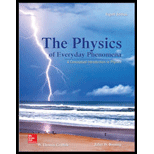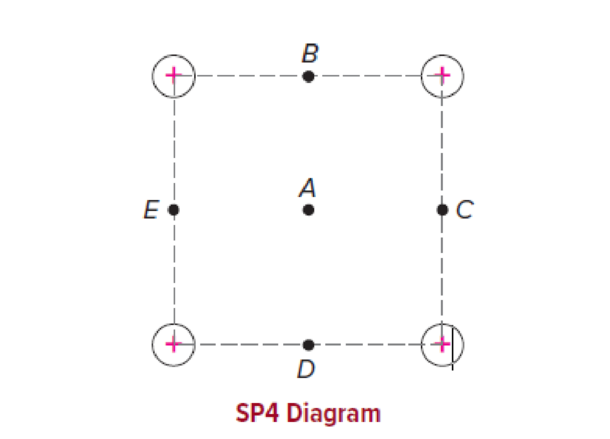
The Physics of Everyday Phenomena
8th Edition
ISBN: 9780073513904
Author: W. Thomas Griffith, Juliet Brosing Professor
Publisher: McGraw-Hill Education
expand_more
expand_more
format_list_bulleted
Concept explainers
Textbook Question
Chapter 12, Problem 4SP
Suppose that four equal positive charges are located at the corners of a square, as in the diagram.
a. Using small arrows, indicate the direction of the electric field at each of the labeled points.
b. Would the magnitude of the electric field be equal to zero at any of the labeled points? Explain.

Expert Solution & Answer
Want to see the full answer?
Check out a sample textbook solution
Students have asked these similar questions
1) 2)
8.
With the aid of a diagram draw the following electric circuit and use the resistor as the load,
(a) Closed circuit
(b) Open circuit
Lab 8 Part 3 PHET Wave Interface simulation.
I am having trouble with this part of the lab.
Chapter 12 Solutions
The Physics of Everyday Phenomena
Ch. 12 - When two different materials are rubbed together,...Ch. 12 - Two pith balls are both charged by contact with a...Ch. 12 - When a glass rod is rubbed by a nylon cloth, which...Ch. 12 - Two pith balls are charged by touching one to a...Ch. 12 - Do the two metal-foil leaves of an electroscope...Ch. 12 - If you charge an electroscope with a plastic rod...Ch. 12 - When you comb your hair with a plastic comb, what...Ch. 12 - Describe how Benjamin Franklins single-fluid model...Ch. 12 - If you touch the metal ball of a charged...Ch. 12 - If you touch the ball of a charged electroscope...
Ch. 12 - When a metal ball is charged by induction using a...Ch. 12 - If, when charging by induction, you remove the...Ch. 12 - Will bits of paper be attracted to a charged rod...Ch. 12 - Why are pith balls initially attracted to a...Ch. 12 - Are electrostatic precipitators (see everyday...Ch. 12 - Can the pollutant carbon dioxide be readily...Ch. 12 - Can scrubbers (see everyday phenomenon box 12.1)...Ch. 12 - Is the concept of torque involved in the operation...Ch. 12 - If you had several identical metal balls mounted...Ch. 12 - If the distance between two charged objects is...Ch. 12 - If two charges are both doubled in magnitude...Ch. 12 - Can both the electrostatic force and the...Ch. 12 - Two charges, of equal magnitude but opposite sign,...Ch. 12 - Is it possible for an electric field to exist at...Ch. 12 - If we change the negative charge in the diagram...Ch. 12 - Three equal positive charges are located at the...Ch. 12 - Is the electric field produced by a single...Ch. 12 - If we move a positive charge toward a negative...Ch. 12 - Prob. 29CQCh. 12 - If a negative charge is moved in the same...Ch. 12 - Prob. 31CQCh. 12 - Is electric potential the same as electric...Ch. 12 - Prob. 33CQCh. 12 - Prob. 34CQCh. 12 - Would you be more likely to be struck by lightning...Ch. 12 - During a thunderstorm, why can a much greater flow...Ch. 12 - If in a typical thundercloud the bottom of the...Ch. 12 - Which is better during a thunderstorm: being in...Ch. 12 - Prob. 39CQCh. 12 - Prob. 1ECh. 12 - Prob. 2ECh. 12 - Prob. 3ECh. 12 - Prob. 4ECh. 12 - Prob. 5ECh. 12 - Prob. 6ECh. 12 - Prob. 7ECh. 12 - Prob. 8ECh. 12 - Prob. 9ECh. 12 - Prob. 10ECh. 12 - Prob. 11ECh. 12 - Prob. 12ECh. 12 - Prob. 13ECh. 12 - Prob. 14ECh. 12 - Prob. 15ECh. 12 - Prob. 16ECh. 12 - Prob. 1SPCh. 12 - Prob. 2SPCh. 12 - Prob. 3SPCh. 12 - Suppose that four equal positive charges are...Ch. 12 - Prob. 5SP
Knowledge Booster
Learn more about
Need a deep-dive on the concept behind this application? Look no further. Learn more about this topic, physics and related others by exploring similar questions and additional content below.Similar questions
- Mick and Rick are twins born on Earth in the year 2175. Rick grows up to be an Earth-bound robotics technician while Mick becomes an intergalactic astronaut. Mick leaves the Earth on his first space mission in the year 2200 and travels, according to his clock, for 10 years at a speed of 0.75c. Unfortunately, at this point in his journey, the structure of his ship undergoes mechanical breakdown and the ship explodes. How old is Rick when his brother dies?arrow_forwardHi, I have canceled, why did you charge me again?arrow_forwardNo chatgpt pls will upvotearrow_forward
- For each of the actions depicted below, a magnet and/or metal loop moves with velocity v→ (v→ is constant and has the same magnitude in all parts). Determine whether a current is induced in the metal loop. If so, indicate the direction of the current in the loop, either clockwise or counterclockwise when seen from the right of the loop. The axis of the magnet is lined up with the center of the loop. For the action depicted in (Figure 5), indicate the direction of the induced current in the loop (clockwise, counterclockwise or zero, when seen from the right of the loop). I know that the current is clockwise, I just dont understand why. Please fully explain why it's clockwise, Thank youarrow_forwardA planar double pendulum consists of two point masses \[m_1 = 1.00~\mathrm{kg}, \qquad m_2 = 1.00~\mathrm{kg}\]connected by massless, rigid rods of lengths \[L_1 = 1.00~\mathrm{m}, \qquad L_2 = 1.20~\mathrm{m}.\]The upper rod is hinged to a fixed pivot; gravity acts vertically downward with\[g = 9.81~\mathrm{m\,s^{-2}}.\]Define the generalized coordinates \(\theta_1,\theta_2\) as the angles each rod makes with thedownward vertical (positive anticlockwise, measured in radians unless stated otherwise).At \(t=0\) the system is released from rest with \[\theta_1(0)=120^{\circ}, \qquad\theta_2(0)=-10^{\circ}, \qquad\dot{\theta}_1(0)=\dot{\theta}_2(0)=0 .\]Using the exact nonlinear equations of motion (no small-angle or planar-pendulumapproximations) and assuming the rods never stretch or slip, determine the angle\(\theta_2\) at the instant\[t = 10.0~\mathrm{s}.\]Give the result in degrees, in the interval \((-180^{\circ},180^{\circ}]\).arrow_forwardWhat are the expected readings of the ammeter and voltmeter for the circuit in the figure below? (R = 5.60 Ω, ΔV = 6.30 V) ammeter I =arrow_forward
- simple diagram to illustrate the setup for each law- coulombs law and biot savart lawarrow_forwardA circular coil with 100 turns and a radius of 0.05 m is placed in a magnetic field that changes at auniform rate from 0.2 T to 0.8 T in 0.1 seconds. The plane of the coil is perpendicular to the field.• Calculate the induced electric field in the coil.• Calculate the current density in the coil given its conductivity σ.arrow_forwardAn L-C circuit has an inductance of 0.410 H and a capacitance of 0.250 nF . During the current oscillations, the maximum current in the inductor is 1.80 A . What is the maximum energy Emax stored in the capacitor at any time during the current oscillations? How many times per second does the capacitor contain the amount of energy found in part A? Please show all steps.arrow_forward
arrow_back_ios
SEE MORE QUESTIONS
arrow_forward_ios
Recommended textbooks for you
 Physics for Scientists and Engineers, Technology ...PhysicsISBN:9781305116399Author:Raymond A. Serway, John W. JewettPublisher:Cengage Learning
Physics for Scientists and Engineers, Technology ...PhysicsISBN:9781305116399Author:Raymond A. Serway, John W. JewettPublisher:Cengage Learning Principles of Physics: A Calculus-Based TextPhysicsISBN:9781133104261Author:Raymond A. Serway, John W. JewettPublisher:Cengage Learning
Principles of Physics: A Calculus-Based TextPhysicsISBN:9781133104261Author:Raymond A. Serway, John W. JewettPublisher:Cengage Learning College PhysicsPhysicsISBN:9781285737027Author:Raymond A. Serway, Chris VuillePublisher:Cengage Learning
College PhysicsPhysicsISBN:9781285737027Author:Raymond A. Serway, Chris VuillePublisher:Cengage Learning College PhysicsPhysicsISBN:9781938168000Author:Paul Peter Urone, Roger HinrichsPublisher:OpenStax College
College PhysicsPhysicsISBN:9781938168000Author:Paul Peter Urone, Roger HinrichsPublisher:OpenStax College College PhysicsPhysicsISBN:9781305952300Author:Raymond A. Serway, Chris VuillePublisher:Cengage Learning
College PhysicsPhysicsISBN:9781305952300Author:Raymond A. Serway, Chris VuillePublisher:Cengage Learning

Physics for Scientists and Engineers, Technology ...
Physics
ISBN:9781305116399
Author:Raymond A. Serway, John W. Jewett
Publisher:Cengage Learning

Principles of Physics: A Calculus-Based Text
Physics
ISBN:9781133104261
Author:Raymond A. Serway, John W. Jewett
Publisher:Cengage Learning

College Physics
Physics
ISBN:9781285737027
Author:Raymond A. Serway, Chris Vuille
Publisher:Cengage Learning

College Physics
Physics
ISBN:9781938168000
Author:Paul Peter Urone, Roger Hinrichs
Publisher:OpenStax College

College Physics
Physics
ISBN:9781305952300
Author:Raymond A. Serway, Chris Vuille
Publisher:Cengage Learning

Electric Fields: Crash Course Physics #26; Author: CrashCourse;https://www.youtube.com/watch?v=mdulzEfQXDE;License: Standard YouTube License, CC-BY